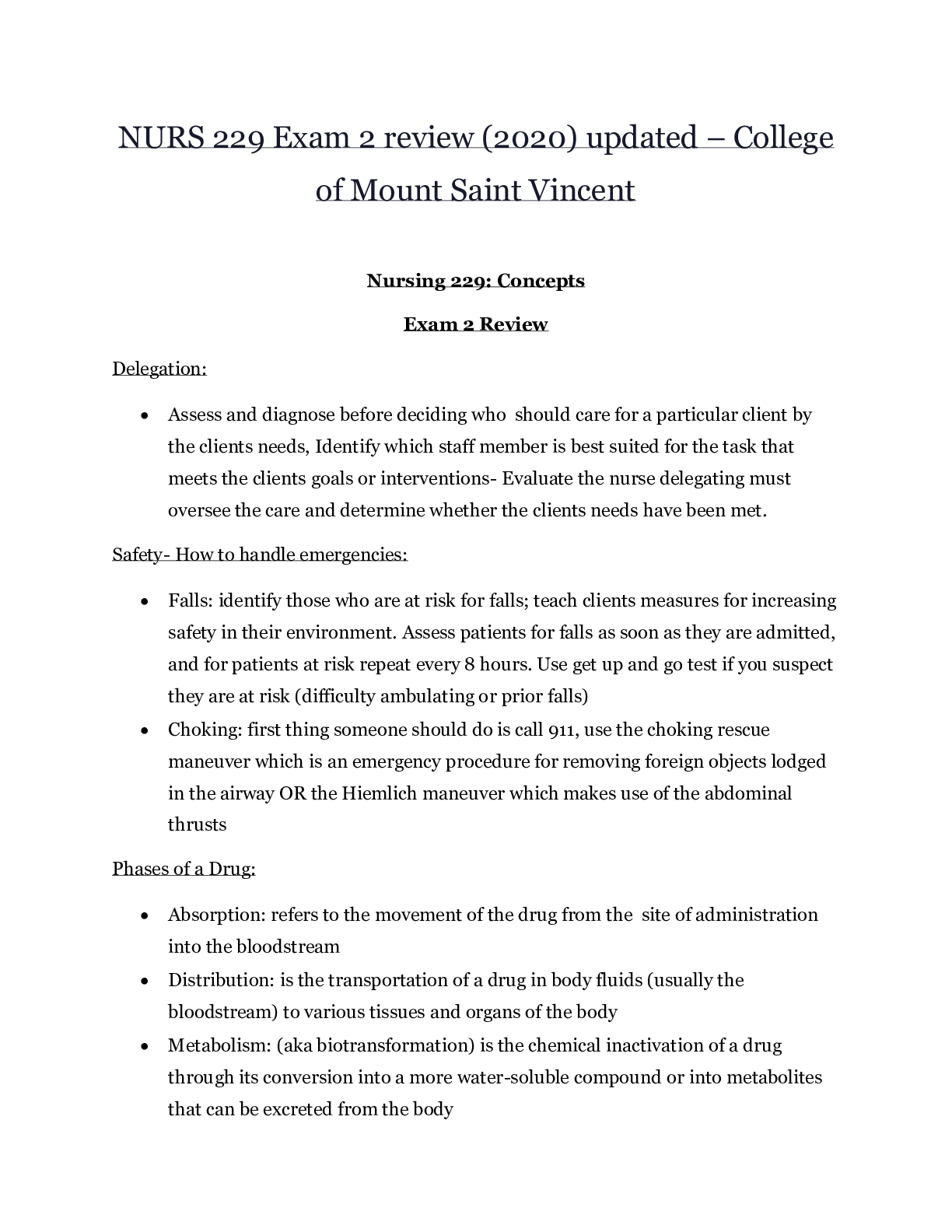*NURSING > Summary > NURS 229 Exam 1 review (2020) updated – College of Mount Saint Vincent | NURS229 Exam 1 review (20 (All)
NURS 229 Exam 1 review (2020) updated – College of Mount Saint Vincent | NURS229 Exam 1 review (2020) updated
Document Content and Description Below
NURS 229 Exam 1 review (2020) updated – College of Mount Saint Vincent Nursing 229: Concepts Exam 1 Review Types of Documentations: • SOAP: Subjective, objective, assessment, plan (interve... ntions, evaluation, revision) -Subjective data: what the patient tells you -Objective data: factual, measurable clinical findings -Assessment: conclusions drawn about data (usually patients problems or nursing diagnosis) -Plan: short term and long term goals -Interventions: actions of healthcare team that are preformed to achieve expected outcomes -Evaluation: an analysis of the effectiveness of interventions -Revision: changes made to the original care plan • Charting by exception (CBE): only significant findings or exceptions to standards and norms of care are charted -uses printed flowsheets -CBE assumes that unless a separate entry is made (an exception) all standards have been met and patient has responded normally -CBE reduces amount of time spent on documentation, reduces repetitive charting of routine care, provides a record that is easily read and understood and clearly highlights any variations from the expected plan of care -Omission are the main problem associated with CBE • PIE: Problem, intervention, evaluation: acquires daily assessment record and progressed notes; nursing focused rather than medical focused record -Problem: use data from original assessment to identify appropriate nursing diagnosis -Intervention: document the nursing actions you take for each nursing diagnosis -Evaluation: document the patients response to interventions and treatments • Narrative: tells a story of patients experience in a chronological format -The goal is to tract the patients changing health status and progress towards goals -useful for a timeline of events (emergency situations) • Focus: views the clients status from a positive perspective rather than the negative focus in problem charting -Uses assessment data to evaluate client care, concerns, problems, or strengths -The focus is often identified as a nursing diagnosis, a sign or symptom, a client behavior, a special need, an acute change in condition, or a significant event -First column=time and date -Second column=the focus or problem addressed in the note -Third column=contains charting in a DAR format (data, action, response) -Data: document subjective/objective data that support the focus (assessment phase) -Action: describe interventions performed (planning and implementation phases) -Response: describe the patients response to your interventions (evaluation phase) Prioritizing patients needs: Human needs=Maslow’s Hierarchy of needs: physiological(food,air,water,sex,physical activity) , safety and - - - - - - - - - - - - - - - - - - - - - - - - - - - - - - - - -Types of knowing: 1) Theoretical knowledge (past; evidence based) 2) Practical knowledge (learn from skills) 3) Self-knowledge (understanding of your own self) 4) Ethical knowledge (difference between right and wrong) Nursing Process: 1. Assessment 2. Nursing diagnoses (put info together and look for a common cause- not medical diagnoses- NANDA: North American nursing diagnoses association ) 3. Planning outcomes (look for a goal) 4. Implementation 5. Evaluation (did it work? Or does the plan have to be revised?) [Show More]
Last updated: 2 years ago
Preview 1 out of 9 pages

Buy this document to get the full access instantly
Instant Download Access after purchase
Buy NowInstant download
We Accept:

Reviews( 0 )
$9.50
Can't find what you want? Try our AI powered Search
Document information
Connected school, study & course
About the document
Uploaded On
Jul 20, 2020
Number of pages
9
Written in
Additional information
This document has been written for:
Uploaded
Jul 20, 2020
Downloads
0
Views
109






